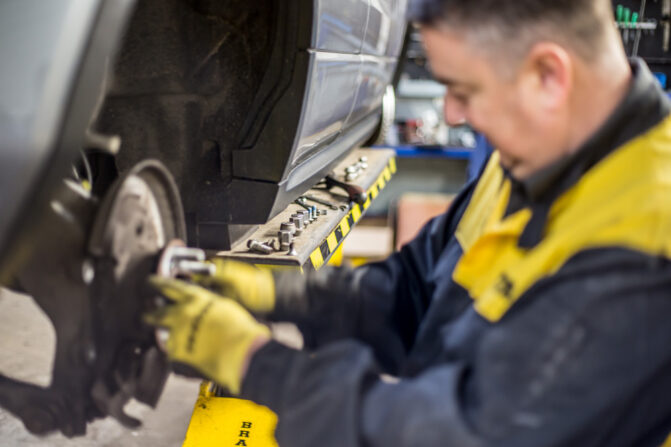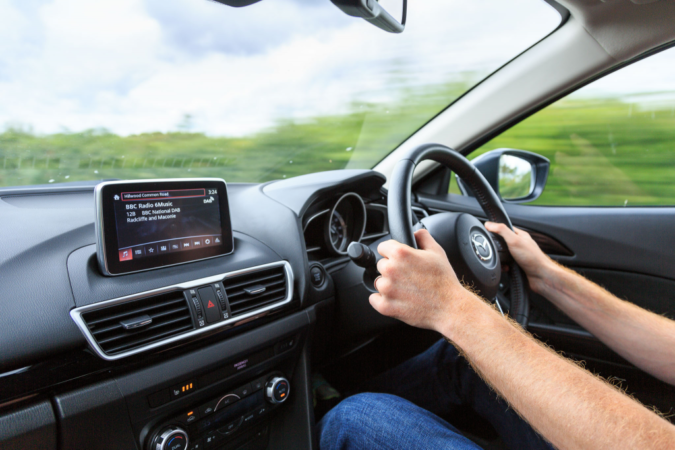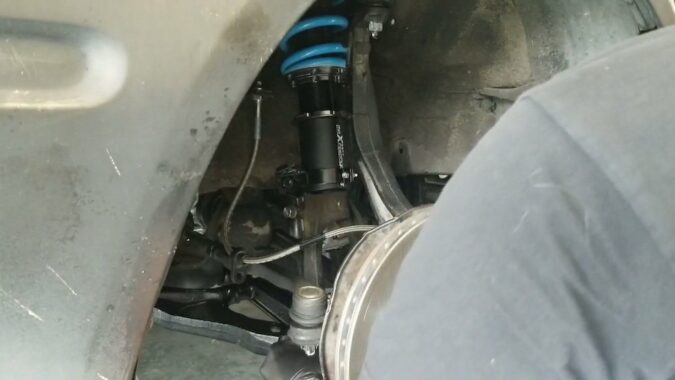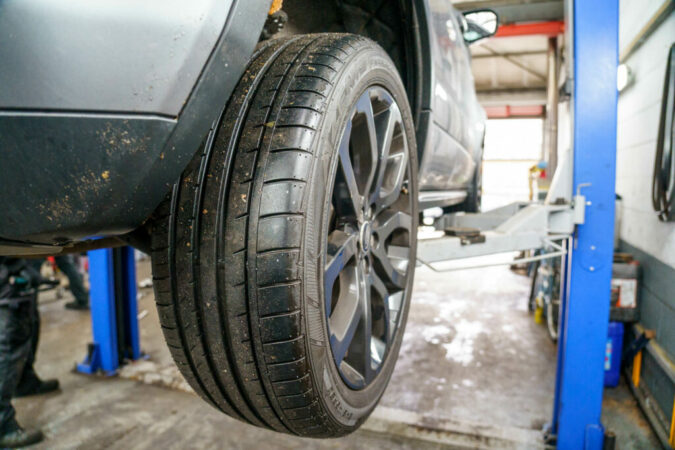Tie rods are an important component of the vehicle’s steering system that connects the steering rack to the steering knuckle. Tie rods not only help move the wheels when steering but can also rotate the vehicle. Simply put, it is impossible to steer a vehicle with a broken tie rod.
Tie rods are used every time you steer your vehicle, making them susceptible to damage and wear. Normal wear can cause the tie rods to fail. Driving hazards such as potholes and accidents can also damage the tie rods.
When a tie rod is damaged and fails, the effects can range from mild (early tire wear) to extreme (loss of vehicle control). Read on to learn the symptoms of tie rod failure and about the repair/replacement process and cost.
- Tie Rod
- Steering Systems
- Broken Tie Rod
- Driving With A Bad Tie Rod
- Broken Tie Rod Symptoms
- Tire Rod Replacement
- Tire Rod Replacement Cost
- Problems After Replacement
- Repair Cost
- Conclusion
- F.A.Q
Tie Rod
Tie rods play an important role in the steering system. Without the tie rods, the steering system will fail. The tie rod is the pivot point between the steering system and the steering arm and wheels, and the outer edge of the tie rod is adjustable. This means that you can change the length of the tie rods to fix the vehicle’s alignment. As you can see, a simple tie rod is very important. You are responsible for turning and allowing you to turn your wheels while steering.
Tie Rod Assembly
The tie rod is part of the vehicle’s steering mechanism. It consists of inner and outer edges. The tie rods transfer power from the middle link or steering rack to the steering knuckle. This will rotate the wheel and connect the outer end of the tie rod to the adjustment sleeve, allowing you to adjust the length of the tie rod. This setting is used to set the alignment angle of the vehicle.
Inner And Outer Tie Rod
Tie rods are useful for maneuvering vehicles. The tie rod has two parts, an inner end, and an outer end. The tie rod works in conjunction with the ball joint to convert power from the center link to the steering knuckle. Simply put, tie rods help you steer and align the front end of your vehicle.
Tie Rods And Steering Systems
Tie rods are an integral part of your car’s steering. As the name implies, the tie rods connect your car’s steering rack to the steering knuckle. The steering arm is attached to the wheel.
Tie Rods In Rack And Pinion Steering
There are two types of steering systems: rack and pinion steering and recirculation ball or mechanical steering. The rack and pinion steering system are straightforward to operate. When you turn the steering wheel, the pinion attached to the steering shaft rolls along with the rack.
Racks mounted on both front wheels move depending on how the wheels rotate. The tie rods transfer power from the steering rack to the steering arm and serve to move the wheels.
Tie Rods In Recirculation Ball Steering
A recirculating ball or mechanical steering system is a bit more complicated than a rack and pinion system. The mechanical system includes a gearbox. The steering shaft rotates multiple gears that control the pitman arm when you rotate the wheel. The drop arm moves the rack according to the movement of the steering.
Again, like the rack and pinion system, the rack is connected to a tie rod that is connected to the steering arm. The tie rod is the connection from the steering system to the wheel. Both of these systems are complex in their own right and include tie rods, which are a very simple but important part.
Broken Tie Rod On Car
Tie rods can fail due to normal wear and rough road conditions. In many cases, the cause of tie rod failure is insufficient lubrication. Road hazards such as potholes or bumps on the road, or heavy hits on curbs can shorten the life of the tie rod end.
These road hazards can damage the tie rods and leak lubricating oil. When this happens, the ends of the tie rods may become loose and restrained, making the vehicle unsafe to drive.
Inspecting Your Tie Rod
Unless you are familiar with the vehicle, it is usually advisable to have a qualified mechanic check if the tie rods can be used safely. As you slide the tie rod up and down, you may see signs of slack or free play on the tie rod. This indicates that the tie rods are worn and need to be replaced.
Another way to check the tie rods is to jack up the vehicle and remove the front wheels. You need to turn the wheel clockwise to see the inner tie rod end on the passenger side, and counterclockwise to see the inner tie rod end on the driver side. If any of the tie rod seals are cracked, leaking, or excessively worn, they need to be replaced.
Broken Tie Rod Accident
Tie rods are steering components that keep the front tires aligned with the steering wheel and help the driver turn the wheel when turning the steering wheel. Symptoms of tie rod wear or damage include rattling when steering, steering wheel play, uneven tire wear, and left-right pulling of the vehicle.
These symptoms may seem like a minor inconvenience, but tire wear alone can cause the vehicle to lose stopping power. In the worst case, if the tie rod fails completely, the wheels will come off the steering and the vehicle will lose its steerability. As soon as the tie rods wear, the steering is in jeopardy and the vehicle cannot drive safely. Worn/defective tie rods should be replaced immediately.
Driving With A Bad Tie Rod
It is extremely dangerous if the tie rods are completely damaged while driving. You will not be able to steer the car, especially at high speeds. If you notice symptoms of tie rod deterioration, take your car to a licensed auto mechanic for inspection as soon as possible.
Effects Of Driving With A Bad Tie Rod
Damage To Underpinnings
If the end of a broken tie rod becomes loose, its joints and links will cause dirt and dirt. These can eventually mix with the lubricant and increase friction. In addition, the lubricant can be moved from the joints and links.
Extra friction and less lubricant from dirt can cause more vibration and noise. In the long run, this can also lead to rust. And for those who don’t know, rust can spread. When it is wide enough, it adversely affects the overall structural rigidity of the car.
Compromised Handling
As we have found, bad tie rods can loosen and result in unresponsive steering. Therefore, no matter how fast the reaction time is, a car with a bad tie rod end will be less agile and agile than a car in peak condition. Of course, this means that there are few opportunities to avoid potential accidents.
Loss Of Traction
If the tie rods are defective, the tires may wear unevenly. If the tires are uneven, the weight distribution will be uneven. This results in the tire contact points being uneven, and overall traction will be reduced.
Low traction increases the risk of accidents. Uneven weight distribution can cause driving problems. Prolonged driving with unevenly worn tires can also affect the car chassis and suspension system.
Broken Tie Rod Symptoms
There are multiple symptoms that may emerge once your tie rod starts malfunctioning. The following are the most significant ones among them.
1. Steering Wheel Vibration
The tie rods hold the suspension parts firmly and firmly. If the end of the tie rod breaks and loosens, the suspension parts will also loosen, and you will feel vibrations on the steering wheel while driving.
2. Loss Of Steering
Bad ends of the tie rods can cause the steering wheel to loosen or play too much. This is a dangerous situation as steering can be completely lost. If you notice that the steering wheel is loose, take your car to an auto repair shop immediately.
3. Clunking Noises And Vibrations
A squeak or squeal while driving may indicate unwanted metal-to-metal contact. High-pitched squeaks while driving the vehicle, especially when cornering, can indicate cracks in the rubber boots at the tie rod ends, which can lead to lubrication loss.
You will hear a rattling noise from the front end of the car. Abnormal noise does not automatically indicate a defective tie rod end, so check this page for other symptoms.
4. Abnormal Wearing Out Of Tires
If the wheels are properly aligned, the tires should wear evenly on all sides. But, if there is a problem with the tie rods, the tire will wear more at the edges rather than at the center. If you have problems with deflation or uneven tire wear, visit your mechanic today. At the very least, the wheels need to be readjusted for better fuel economy.
5. Decrease In MPG Numbers
If a bad tie rod is causing wheel misalignment issues, mpg can also be affected. Misaligned wheels increase fuel consumption by up to 10%. That’s about 31 cents more per gallon at today’s price.
Tie Rod Replacement
It is not strictly necessary to replace both tie rods at the same time, but many mechanics may recommend different combinations of replacement parts. When replacing the inner bar, if the outer bar is an original part, it is recommended to replace both.
This is because changing the inner tie rod requires removing the outer tie rod (if you want to know more, check out our explainer on outer tie rod replacement). Replacing the inner and outer tie rods at the same time will help save labor costs and prevent future problems. If the outer tie rod is bad, but the inner tie rod is still in good condition, it is not advisable to have to replace both.
In the case of both the outer and inner tie rods having approximately the same mileage, they may be experiencing similar wear. It is advisable to replace them together if the visual condition of the tie rods shows signs of corrosion (which might require that you learn how to fix rust on a car) or other excessive wear.
All defective tie rods must be replaced before proper alignment can be done. Because defective tie rods cannot be used for proper alignment. Replacing all failing tie rods is necessary as this saves time and money in the long run.
Tie Rod Replacement Cost
Tie rod replacement is not a major repair. It’ll cost you about $20 to $100 per tie rod. However, labor is quite expensive and you have to pay for at least an hour. Assuming an average mechanic fee of $80 to $120 per hour, you’re looking at a workforce of at least $80.
Some people choose to replace all four bars at once. There are a total of 4 tie rod assemblies. The design of the rear wheel is simpler than the front one. Changing the bar at the same time makes sense. They were all installed at the same time, so they will probably go down at the same time.
Broken Tie Rod: Some Factors Affecting The Replacement Cost
Higher Cost of Inner Tie Rods
Replacing tie rods costs $80 to $120. Inner tie rods are usually more expensive than outer tie rods. In some cars, interior and exterior parts are sold as assemblies. Labor costs depend on the difficulty of the job. But they average between $145 and $185. If the inner end of the tie rod needs to be replaced, the cost of replacing the tie rod will be higher. It takes a little more effort to remove and replace the damaged one.
Cost Differs According To Location
The total cost also depends on the location. There are states and territories where labor costs are low. If you live in such an area, labor costs can be below average. On average, the total labor cost for tie rods and tie rod ends is about 50% of the total labor and material costs.
You need to get OEM parts instead of counterfeit parts to maximize the value of their labor costs. Original spare parts are often weaker, more durable, and meet standards than cheaper parts that do not fully meet specifications and do not last long.
If you replace the car tie rod and the end of the tie rod, you will also need to adjust the front wheels. In other words, you also need to add wheel alignment to the total cost. The average cost of this tire service is between $80 and $100.
Problems After Tie Rod Replacement
1. Toe Angle Issues
One of the first problems encountered after replacing a tie rod is the misalignment of the toe angle. The most common cause of toe angle problems is the installation of tie rods that do not match in length. One-sided toe adjustment is another reason for toe angle problems. If you drive at an off-toe angle, the suspension may be damaged and locked in if not corrected immediately.
2. Unsteady And/Or Vibrating Steering Wheel
Another problem that can occur after replacing a truck linkage is steering wheel instability, especially when driving on smooth, flat roads. Since the tie rods are responsible for the steering, improperly installed tie rods can affect the steering wheel if they are not installed correctly or if problems occur.
Replacing the tire rods is supposed to correct the steering wheel vibrations. But if the problem persists after the replacement, you will need to replace the new tie rod. Shaking the steering wheel may seem less disturbing, but it is usually an early sign of something wrong with the steering system.
3. Uneven Tire Wear
After replacing the tie rods, the wheels may wear faster or become uneven. Looking at the tire tread wear pattern, you can see that the wear is not uniform. Normally, the suspension and steering system components are properly locked.
Hence, the weight of the vehicle is evenly distributed across all wheels. Non-uniform tire wear affects driving performance and also the balance of the vehicle. Hence tie rod replacement should be reconsidered.
4. Increased Fuel Consumption
If you are very enthusiastic, you may find that you have high fuel economy after replacing your tie rods. This issue occurs when tie rod replacement is inefficient. Your misaligned wheels have increased drag on the road leading to more fuel consumption. Wheel alignment is used to return the toe angle to the vehicle’s specifications. If you forget to do wheel alignment after replacing the tie rods, all of the above issues will occur. The repairs may be more expensive.
Reasons For A Replacement Tie Rod Causing Problems
Sometimes, you might experience some issues even after replacing a broken/faulty tie rod. The following are some of the most serious issues that could happen after a tie rod replacement.
Improper Installation
Careless and improper installation is a common cause of tear rod replacement problems. Improper installation can occur for a variety of reasons, including inexperienced mechanics and bad DIY vendors.
Tie rods are one of the most commonly used automotive parts, so always double-check your work when installing yourself. When choosing a mechanic, choose someone you can trust or have a solid verifiable review.
A good mechanic may charge you a little upfront (as would the best car repair shop near me), but in the long run, you can save thousands. In many places, tie rods can be replaced by simply counting the number of revolutions it takes to remove the old one and reverse it with the new one. This may work, but some adjustments are needed to make sure it’s okay, and many skip this step.
Improper Alignment
Tie rods allow you to steer and drive the car straight when the steering wheel is in the center. When aligning the wheels of a car, turn the nuts on the threads to adjust the tie rods. After replacing the tie rod, if this is done improperly or not at all, that could mess up the drivability of the car.
Failure Of The Replacement Rod
Parts are designed to last a long time, but this is not always the case and things can break. This may be the case for a replacement tie rod. Aftermarket parts do not have the same quality control as OEMs, so it is not uncommon for even new parts to fail from time to time.
Tie Rod Repair Cost
The cost of replacing a tie rod is based on a variety of factors, including vehicle type, quality of parts, and difficulty in accessing parts. A rough estimate is that costs range from $100 to $400 plus additional charges and taxes.
The cost of repair of inner or outer rods ranges from about $20 to $120, depending on the quality. If the bar outside you is a problem, the job can cost you about $50 to $100. The inner tie rods are expensive to repair and replace. The mechanic can charge you anywhere from $100 to $300 for labor costs.
Keep in mind that labor costs are highly dependent on the local market and the type of car you drive. Luxury cars usually require more work and therefore involve more work. Try replacing the outer bar yourself to save money. The outer bar is easier to replace than the inner bar.
Broken Tie Rod: Things To Remember While Replacing A Tie Rod
When replacing tie rods, it is important to remember these tips to reduce the risk of premature failure of the tie rods.
Ensure Compatibility
Tie rods are not universally designed. What fits in one car may not work in your car. When buying a replacement tie rod, always make sure it is compatible with the old one or always refer to the manufacturer’s recommendations.
Lubrication
If you replace the tie rod yourself, be sure to check the owner’s manual for the correct torque value. If the torque is incorrect, the tie rods will fail prematurely. Lubricate nuts and other joints, such as WD40, to minimize friction.
Wheel Alignment
Be sure to perform a wheel alignment after replacing the tie rods. If you replace it yourself, ask a reputable car dealer to make adjustments. If you have a mechanic to replace the tie rods, always make sure the alignment is complete and request a report. In most cases, the mechanic will calculate the alignment separately from the tie rod replacement.
If a problem occurs after replacing the tie rod, it indicates an early failure of the tie rod. The steering wheel may loosen or the axle may be misaligned. Failure to address this issue early can lead to accidents. These problems are usually caused by poor or missing wheel alignment after replacing the tie rods, defective replacement parts, or incorrect tie rods in the car.
Conclusion
This article discussed all about tie rods and their functioning. First, we learned about the function and working process of a tie rod and about its significance.
Next, we looked at the potential issues that could affect the functioning of a tie rod and the repair/replacement process. Now you have an idea of things to keep in mind while maintaining or replacing tie rods.
F.A.Qs On Broken Tie Rod
How Much To Fix A Broken Tie Rod
Most tie rods range in price from $40 to $120, with inner tie rods being more expensive than outer tie rods. Some cars have tie rods, and the inner and outer tie rods are sold together as an assembly. The effort to replace the tie rods can cost $45 to $85, depending on whether you change the inner or outer tie rods.
Can You Drive With A Broken Tie Rod
You can usually continue to drive the vehicle with worn tie rods. But if it fails completely, steering control will be lost. This could actually result in a crash and damage to the car. You will have to tow it to a service center for repairs.
What Is A Tie Rod
Tie rods are an essential component for accurate steering on all vehicles. The working tie rods connect the suspension and steering to the front wheels on the ground via multiple joints, allowing the wheels to rotate accurately with the steering wheels. Such a system allows the driver to rotate the vehicle with minimal force.
How To Replace Tie Rod Ends
Replacing the tie rod end refers to repairing an integral part of the vehicle’s steering mechanism. Some basic tools and a little know-how are required. But, this is a process that anyone with little car experience can do on their own.
What Are The Symptoms Of A Bad Tie Rod
There are a number of symptoms that denote the fact that your car has a bad or dysfunctional tie rod. These include poor wheel alignment, uneven wear of tires, clunking noises, and a vibrating/unresponsive steering wheel.
How Much Is A Tie Rod Replacement
Tie rod replacement is not a major repair. It’ll cost you about $20 to $100 per tie rod. However, labor is quite expensive and you have to pay for at least an hour. Assuming an average mechanic fee of $80 to $120 per hour, you’re looking at a workforce of at least $80.
What Does A Bad Tie Rod Sound Like
A bad tie rod could cause knocking or cranking noise from the front of the vehicle. Especially when turning at low speeds, maybe a symptom of a defective tie rod. Loose tie rods can cause rattling noise in the pivot and handlebars.
What Happens When A Tie Rod Breaks
If a tie rod is damaged and fails, its effects can range from minor tire wear to extreme loss of vehicle control.




